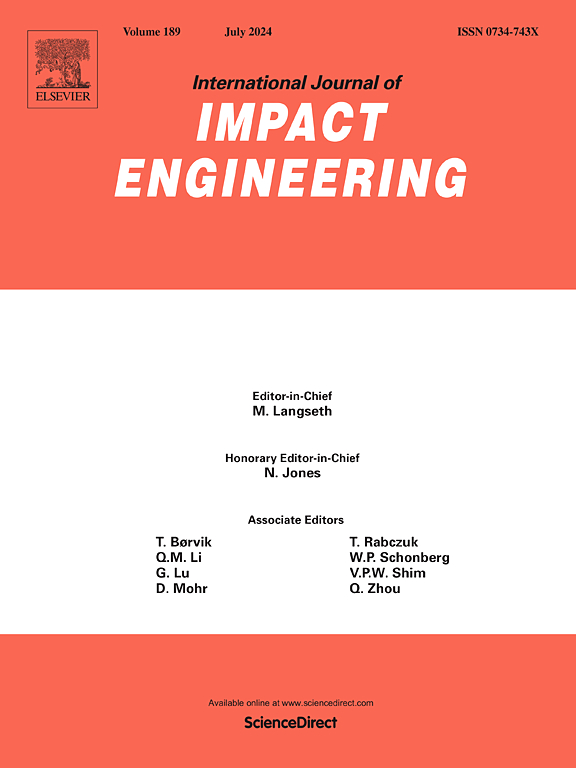冲击作用下比例模型的破坏相似度
IF 5.1
2区 工程技术
Q1 ENGINEERING, MECHANICAL
International Journal of Impact Engineering
Pub Date : 2025-09-29
DOI:10.1016/j.ijimpeng.2025.105548
引用次数: 0
摘要
在比例模型冲击试验条件复杂、冲击能高的情况下,材料往往表现出明显的损伤或破坏。由于材料变形的影响,通常很难严格满足模型试验的几何相似性。同时,材料的损伤或破坏行为进一步引入了更为复杂的相似要求,使得在模型试验中更加难以充分考虑材料的热粘塑性本构性能和损伤或破坏特征,实现全面的相似。为了克服这一问题,进一步拓展材料损伤或破坏行为的相似规律,本研究提出了一组与材料破坏应变相关的材料无因次数,并分析了其物理意义。随后,以实例推导了这些失效准则对应的无因次数的具体表达式,反映了材料失效应变与应力三轴性、应变速率和温度等相关的本质特性。通过中速泰勒杆冲击试验、扁头刚性弹丸冲击中靶、凸头刚性弹丸击穿薄靶等不同冲击条件的数值模拟结果,验证了新无因次数的合理性和实用性。在此基础上,提出了考虑材料热粘塑性和损伤破坏行为的比例模型试验中选择最佳相似材料的基本方法。结果表明,在满足材料的热粘塑性相似度后,通过进一步引入材料的破坏相似准则,选择热粘塑性相似度和破坏相似度都较好的相似材料,可以准确地复制原型结构的变形和损伤或破坏特征。同时,当结构的损伤或破坏行为比其塑性变形更重要时,破坏相似度的要求更为重要,相应地允许材料的热粘塑性相似度适当松弛。提出的考虑材料损伤或破坏特性的无因次数,以及相应的最佳相似材料选择方法,对于通过比例模型试验准确预测原型结构在冲击作用下的危险点并采取相应的防护措施具有重要意义。本文章由计算机程序翻译,如有差异,请以英文原文为准。
Failure similarity of scaled model under impact
Materials often exhibit significant damage or failure when the impact test conditions of scaled model are complex and the impact energy is high. Due to the influence of material distortion, it is usually hard to strictly satisfy the geometric similarity for model test. Meanwhile, the damage or failure behavior of materials further introduces more complex similarity requirements, and thus it is much more difficult to fully consider the thermal-visco-plastic constitutive properties as well as damage or failure characteristics of materials in model test and achieve comprehensive similarity. In order to overcome this problem and further expand the similarity law of the damage or failure behavior of materials, the present study proposes a set of material dimensionless numbers related to material failure strain and analyze its physical meaning. Subsequently, the specific expression of these dimensionless numbers corresponding to the failure criterion is deduced as an example, which reflects the essential properties of the dependency of material failure strain on stress triaxiality, strain rate and temperature, etc. The rationality and practicability of new dimensionless numbers are verified based on several numerical simulation results involving various impact conditions, including Taylor bar impact test with moderate velocity, flat-nosed rigid projectile impacts medium target, and ogive-nosed rigid projectile perforates thin target. Based on these results, the basic method of selecting the optimum similitude material in scaled model test considering both thermal-visco-plasticity and damage or failure behavior of materials will be proposed. It is demonstrated that after the satisfaction of thermal-visco-plastic similarity of materials, the scaled model can accurately replicate the deformation and damage or failure characteristics of prototype structure by further introducing the failure similarity criterion of materials, and selecting the optimum similitude materials with both thermal-visco-plastic similarity and failure similarity. Meanwhile, in the case that the damage or failure behavior of structure is more significant than its plastic deformation, the requirement from failure similarity is more important, and correspondingly the appropriate relaxation for thermal-visco-plastic similarity of materials is allowed. The proposed dimensionless numbers considering material damage or failure properties, as well as the corresponding selection method for optimum similitude materials, are of great significance for accurately predicting the dangerous points in prototype structure under impact and taking protective measures accordingly by the scaled model test.
求助全文
通过发布文献求助,成功后即可免费获取论文全文。
去求助
来源期刊

International Journal of Impact Engineering
工程技术-工程:机械
CiteScore
8.70
自引率
13.70%
发文量
241
审稿时长
52 days
期刊介绍:
The International Journal of Impact Engineering, established in 1983 publishes original research findings related to the response of structures, components and materials subjected to impact, blast and high-rate loading. Areas relevant to the journal encompass the following general topics and those associated with them:
-Behaviour and failure of structures and materials under impact and blast loading
-Systems for protection and absorption of impact and blast loading
-Terminal ballistics
-Dynamic behaviour and failure of materials including plasticity and fracture
-Stress waves
-Structural crashworthiness
-High-rate mechanical and forming processes
-Impact, blast and high-rate loading/measurement techniques and their applications
 求助内容:
求助内容: 应助结果提醒方式:
应助结果提醒方式:


